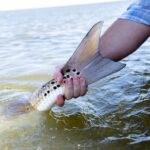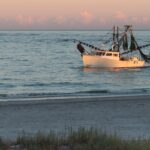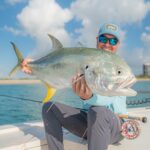
Bowfishing Banned in Biloxi Marsh
Feature Photo: Carter Abramson | Simms Fishing at the Fisheries Science Symposium We have more
“The striped bass population is fine! We don’t need to change anything. The oceans are warming, and the fish are moving north to Canada. Have you seen those drone videos of the spawns over the border? It’s insane how many fish there are!”
How often have we heard some version of this scientifically inaccurate portrayal of our Atlantic striped bass fishery? Too many times to count. Admittedly, it is understandable how some may come to this conclusion. The domestic stock is in really bad shape and another in relatively close proximity is beginning to boom. The intentions of most aren’t to muddy the waters of productive management conversations. In reality, those who are well aware of the nuanced differences between the two situations are the ones posing a threat to our striper management.
The history of the striper fishery in Canada is marked by depletion, management action, and resulting population rebound. Striped bass, native to the coastal waters of Canada, have been a historically important species for Canadian fisheries. They have a unique chapter in the country’s history of commercial fishing. In the latest episode of The Guide Post Podcast, ASGA’s Kyle Schaefer was joined by guest Andrew Murphy to discuss the history of the fishery and his business, Gaspe Coastal.
In the episode, Murphy provides a compelling tale of the trials of our favorite striped fish in Canada, referencing written accounts of population issues as early as the mid-1800s. The Canadian government implemented a commercial and recreational moratorium in the early 2000s, after research estimated the spawning stock population to be a mere couple thousand fish.
By the late 2010s, the Canadian population of striped bass began to show positive signs of response to the fishing relief. Unfortunately for the sanctity of discussion in our waters, this rebound boom lines up with negative trends in US waters. In Episode 129 of The Guide Post, the two guides reference genetic distinctions between these two populations. Murphy goes as far as breaking down the three genetically distinct sub-populations within Canadian waters.
Per Dr. Samuel Andrews from the Coastal Ecology Lab at Acadia University, “Canada has 3 genetically distinct populations: the Saint John River (Bay of Fundy), the Shubenacadie River (Bay of Fundy) and the Miramichi River (SGSL). The Saint Lawrence River population was extirpated, but it was then re-stocked with fish from the Miramichi. Striped bass populations in Canada are much more genetically distinct from each other and from the US populations, then US populations are from each other.”
Our country’s border represents a steadfast line for striped bass management. There are many red flags surrounding our domestic population and their counterparts up north have very little involvement in the solutions to getting our fishery back on track. At most, the recovery of striped bass fishery in Canada highlights the importance of conservation measures and the potential for recovery when angling pressure is mitigated. Do we want our population to fall as low as it got in Canada? Do we want to wait a decade or two until we see a recovery? Or, do we want to fix things ASAP in the Atlantic so we can minimize recovery time?

The podcast is filled with other first-hand experiences of the evolving angling opportunities up north. Striped bass are a very easily accessible fish, as so many American anglers know and love. And while some modern conversation has termed Canadian stripers as nuisance fish in northern waters, Murphy doesn’t agree, citing that historical data doesn’t support this opinion. “They’re native fish with native genetics. We have records that they’re historically present at significant levels. But they make a great scapegoat for other fisheries management and habitat issues”, says the small business owner. “We have so many forgotten fisheries […] we tend to forget quickly what our fisheries used to be. There’s a threat of shifting baselines.”
Andrew still recognizes some concerns about evolving river usage for spawns in Canada, claiming that fish used to spawn in more tributaries than they have been in recent years. “All of our eggs are in one basket”, with one extremely productive spawning site carrying a lot of the load (and producing some insane drone videos). American striper anglers are just now beginning to feel the implications of a single spawning estuary carrying too much of the weight. The Chesapeake Bay contributes more than 75% of all the spawning productivity for Atlantic striped bass annually. In the last five years, Chesapeake spawning metrics have been abysmal, painting a bleak outlook for stock health in the next decade. Kyle notes that, as the Canadian fishery is so fresh off a mortarium, the big fish caught in the coming years will stand as trophies from a success story. “Those fish were spawning right as the industry gave the stock a break”, notes Schaefer, “so those 40” fish you’re catching now are likely the genetic leaders [for the stock going forward.]”

The story of Canadian stripers isn’t a story of shifting stocks. It is a story of dramatic overfishing and a long moratorium. It is also a story about a fish being gone so long that people forgot how good things used to be. This case study reminds of the people who swear “the fishing for our striped bass is better than ever!”, showcasing their lack of experience with this fishery (or a case of selective memory). Let’s hope that our stocks continue to trend upward like our friends up North.
You can listen to the entire episode on all major podcast platforms – Apple Podcasts, Spotify and Google Podcasts. Once you’ve done so, leave a comment on the blog below and let us know how tales from north of the border influence your perspective on the outlook for striped bass in the United States.

Feature Photo: Carter Abramson | Simms Fishing at the Fisheries Science Symposium We have more

Each year, hundreds of millions of fish are killed as collateral damage from large-scale, inshore

Feature Photo Credit: Scientific Anglers Team At the heart of the Jack Project is a

Header Photo: Camden Spear Over the past several years, ASGA has consistently championed science-based, precautionary
We rely on our members and donations to keep fighting for a sustainable tomorrow in marine conservation.
GIVE THE GIFT OF FISHERIES CONSERVATION THIS HOLIDAY SEASON. SHOP ASGA GOODS THAT FUND FISHERIES RESEARCH & ADVOCACY CAMPAIGNS
JOIN ASGA IN CALLING FOR CRITICAL MANAGEMENT ACTION AFTER YEARS OF SPAWN FAILURES & POOR MANAGEMENT.
By using this website, you agree to our use of cookies. We use cookies to provide you with a great experience and to help our website run effectively. To learn more, please review our privacy policy.